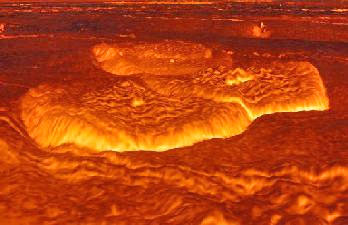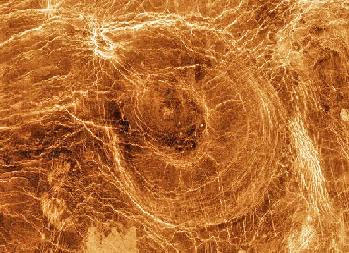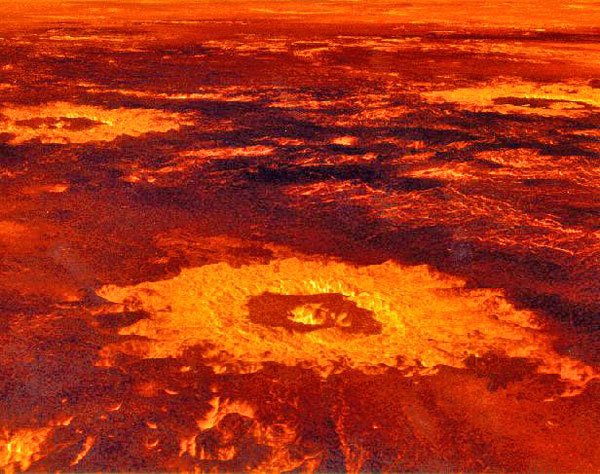|
CHAPTER 5
LUMINOUS VENUS
Venus is the second planet from the Sun. It has often been referred to as
Earth’s sister planet.
With a diameter of 7,700 miles, Venus is very
slightly smaller than the Earth.
It has always been known that Venus is much
hotter than the Earth.
The Missing Oceans of Venus
The evidence suggests that Venus should have a lot of water. Some scientists
believe that the photodisassociation of water molecules and the resultant
escape of hydrogen into space is the reason why Venus has no more water.
But
is the water really gone? Or is it now below the surface?
Analyses of the Venusian atmosphere led
C. A Wood and D. Amsbury to suggest in 1986 that:
“The discovery of a surprisingly high deuterium/hydrogen ratio in Venus
immediately led to the peculation that Venus may have once had a volume of
surface water comparable to that of the terrestrial oceans.”
They suggested
that various terrain features seen in the Venera 15 and 16 radar images
might be salt deposits which have remained after the Venusian oceans had
evaporated.

It would appear that Venus did once have oceans of water.
Venus must have
been cooler in the past, perhaps before its Inner Sun got started? The
planet might have condensed, cooled down and formed a solid planet. Then as
things began settling down, and the inner nuclear reaction got going, the
Inner Sun caused lava to flow onto the outer surface of the planet, to
evaporate the oceans of water and bury the salt.
The water vapor might well
have ended up inside Venus once things had cooled down inside, and much of
the atmosphere was sucked inside – leaving mostly carbon dioxide on the
outside. Most of the heat from the Inner Sun’s start-up would have reached
the outer surface of the planet in the form of lava and hot gases.
Of the
craters mapped by Magellan, very few show any signs of aging (i.e. tectonic
movements, lava-filling, etc.). The surface of Venus should be hundreds of
millions of years old, yet it looks freshly minted. It seems to me as if
there is some pretty strong evidence which shows that Venus did indeed once
have water in oceans and rivers.
But then something catastrophic happened
which changed all that.
The Planetary Greenhouse
Why is Venus so hot?
At first the answer would seem simple: the planet is
closer to the Sun, and the greenhouse effect of the gases in its atmosphere
has caused it to retain the heat it gets from the Sun, thus causing it to
become hotter and hotter. Not all scientists think that the Greenhouse
effect alone can account for the high Venusian temperatures. Venus is
generating far more heat than it should.
Working with data from the Pioneer
Venus Orbiter, F. W. Taylor,
“… found that Venus radiates
15 per cent more
energy than it receives. To keep the surface temperature constant,
Venus
must be producing this extra heat from within. All the inner planets,
including the Earth produce internal heat from radioactive elements in their
rocks.
But Taylor’s observations of Venus would mean that the planet is
producing almost 10,000 times more heat than the Earth – and it is
inconceivable, according to present theories of planetary formation, that
Venus should have thousands of times more of the radioactive elements than
the Earth does…”
Venus is generating far more heat than it should. Note too,
that this is estimated to be some 10,000 times more heat than the Earth.
This might not necessarily require 10,000 times more radioactive elements.
It might merely mean it has an Inner Sun which is more active than the one
inside the Earth, and that Venus is better able to retain its heat.
The
source of this heat is a mystery. Clearly it is of internal origin and has nothing to do with the Sun, or the Greenhouse effect.

Annular Phase of Venus
In order to appreciate some of the amazing things which take place on
Venus,
let us examine some of the characteristics of its atmosphere.
The
atmospheric pressure at ground level is between 92 to 95 times that of the
Earth. There are also clouds at altitudes of 48 and 68 Km. These clouds have
a particle density comparable to thick mist observed at the surface of the
Earth. Scientists have long suspected that its atmosphere is highly
refractive (i.e. its ability to bend light is considerable). They expect
this because of its tremendous atmospheric pressure.
On Earth we have a
similar effect in the polar regions. The extremely cold air causes light to
perform numerous tricks. But on Venus the effects are far greater. In this
section we will take a look at how light from the Sun bends right around
the planet in all directions. Once the Reader understands this effect, many
other phenomenon on Venus will begin to make a lot more sense.
Many astronomers noted that as Venus passed in front of the
Sun, that Venus
would begin developing “horns” at its cusps. These “horns” were the result
of the Sun’s light being refracted through the polar regions of Venus.
 Most amazing of all were the occasions when half of Venus still had not made
contact with the Sun, and yet light was seen shining from the side of Venus furthest away from the Sun. In other words , the light from the Sun had been
sharply refracted. Most amazing of all were the occasions when half of Venus still had not made
contact with the Sun, and yet light was seen shining from the side of Venus furthest away from the Sun. In other words , the light from the Sun had been
sharply refracted.
At other times a bright ring would form around Venus
before contact – sometimes this would happen a day before or after contact
with the Sun. The highly refractive Venusian atmosphere may be bending not
only the light of our Sun.
Perhaps it also bends light emanating from an Inner Sun which lies at the centre of Venus.
Ashen Light of Venus
Sometimes a soft glow is observed on the night side of Venus.
The radiated
light is usually described as grayish, but it has also been described as greenish and coppery. There seems to be no pattern to the occurrence of the
ashen light. There are many reports of instances of the night side of Venus
being visible. For Venus to be visible all the way from the
Earth, it must
be emitting quite a strong light. Even at its closest approach to Earth,
Venus is still more than 100 times the distance of the Moon from us.
In some ways the Ashen Light of Venus seems to be a type of
auroral
activity. However, unlike here on Earth it is not confined to the polar
regions. Something is lighting up enormous sections of Venus – and sometimes
the entire night side of the planet is lit up. Since Venus is almost the
same size as the Earth, the Reader may appreciate the scale of lighting we
are talking about.
What form of light could light up continent sized areas –
so that it can be seen from 26 million miles – up to perhaps 90 or more
millions away?
Bright Spots
Strange bright spots shine on the day side of Venus for apparently no
reason.
This phenomenon may be related to the bright polar caps of Venus. It
might be caused by an Inner Sun’s light being refracted under suitable
atmospheric conditions when various clearings exist in the atmosphere.
Another possible explanation may be that these spots might be intense
concentrations of disassociated atoms from inside the planet.
They may be
the day time extension of the Ashen light, except that one only sees them
when they are so intensely concentrated as to be brighter than the rest of
the clouds on the day side. When all things are considered however, I tend
to favor the Ashen light as the explanation for these bright spots. But
some reports refer to bright spots with “scintillating, star-like” qualities
which may favor some assistance from a central Sun.
The famous French
astronomer L. Trouvelot reports:
“From Nov. 13, 1877 till Feb. 7, 1878, two
remarkable white spots, strongly reminding me of those seen on Mars, have
been observed on the opposite limbs, near the extremity of the cusps.
The
southern spot, which always appeared the brightest, became very prominent
from Jan. 16, 1878, till Feb. 5, and appeared then to be composed of a
multitude of bright peaks forming on its northern border a row of brilliant
star-like dots of light…”

The above instance may be related to the existence of an Inner Sun. These
spots are in the vicinity of the cusps (poles). He notes how the southern
spot is generally the brightest.
Could it be that temporary clearings in the Venusian polar regions are responsible for some of the light from a Central
Sun to be causing this?
|